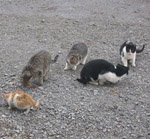How do frogs respond to forest disturbance? Follow the gene flow...
 Evolutionary Bio,
Evolutionary Bio,  Forest,
Forest,  Herps
Herps  Ascaphus truei was considered a single species until 2001 when evidence presented in the journal Evolution prompted the Rocky Mountain tailed frog to be promoted from a subspecies to its own species. Image credit, Jeffrey Marsten.A new study published in the journal Biological Conservation illustrates how landscape genetics can be used to discover how wildlife populations respond over time to anthropogenic and natural forest disturbances.
Ascaphus truei was considered a single species until 2001 when evidence presented in the journal Evolution prompted the Rocky Mountain tailed frog to be promoted from a subspecies to its own species. Image credit, Jeffrey Marsten.A new study published in the journal Biological Conservation illustrates how landscape genetics can be used to discover how wildlife populations respond over time to anthropogenic and natural forest disturbances.
Stephen Spear and Andrew Storfer from Washington State University conducted genetic sampling of Rocky Mountain tailed frogs (Ascaphus montanus) across north-central Idaho at sites that were either subject to timber harvesting or historic wildfires and found that the responses to the two disturbances were very different.
Rocky Mountain tailed frogs have among the lowest thermal and desiccation tolerances recorded, and generally live in forested areas. Given that both timber harvesting and wildfires remove forest canopy, one might expect both disturbances to lead to a fragmentation of populations and subsequent decrease in genetic flow over time with potential negative consequences for population persistence.
However, the researchers found that in areas historically burned by wildfires, genetic flow was largely maintained across the landscape with connectivity limited by the level of solar radiation. Meanwhile, in the timber harvesting areas, genetic connectivity was lower and the pattern of genetic flow followed riparian corridors.
The authors hypothesize that forest fires leave behind a biological legacy of snags, brush, and other woody debris and this provides sufficient cover for the frogs. However, in timber clearcuts, the little left behind is often burned to return nutrients to the soil. The results suggest that in these harvested landscapes, the frogs need to follow riparian corridors to persist.
Given these findings, the authors conclude that in areas subject to timber harvesting, managers should retain healthy riparian corridors to support the continued existence of the Rocky Mountain tailed frog. An alternative approach might be to manage timber harvesting in a way that leaves behind brush and woody debris similar to wildfires.
Interestingly, past research from these same authors found evidence that the disjunct sister species, the coastal tailed frog (Ascaphus truei) whose range extends through the Pacific Northwest and British Columbia experienced population declines in timber harvested areas. Unlike its Rocky Mountain relative, the coastal tailed frog did not exhibit gene flow along riparian corridors.
This shows that wildlife biologists have to be very careful about generalizing findings from one species to another, even if they are closely related taxonomically.
--Reviewed by Rob Goldstein
Spear, S., & Storfer, A. (2010). Anthropogenic and natural disturbance lead to differing patterns of gene flow in the Rocky Mountain tailed frog, Ascaphus montanus Biological Conservation DOI: 10.1016/j.biocon.2009.12.021




Reader Comments